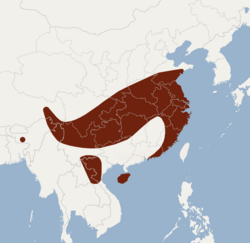| Chinese water myotis | |
|---|---|
| Scientific classification | |
| Domain: | Eukaryota |
| Kingdom: | Animalia |
| Phylum: | Chordata |
| Class: | Mammalia |
| Order: | Chiroptera |
| Family: | Vespertilionidae |
| Genus: | Myotis |
| Species: | M. laniger |
| Binomial name | |
| Myotis laniger Peters, 1871 | |
 | |
The Chinese water myotis (Myotis laniger) is a species of vesper bat. It is native to eastern India, Vietnam and China where it is found in forest habitats. It is believed to roost in caves and hollow trees.
